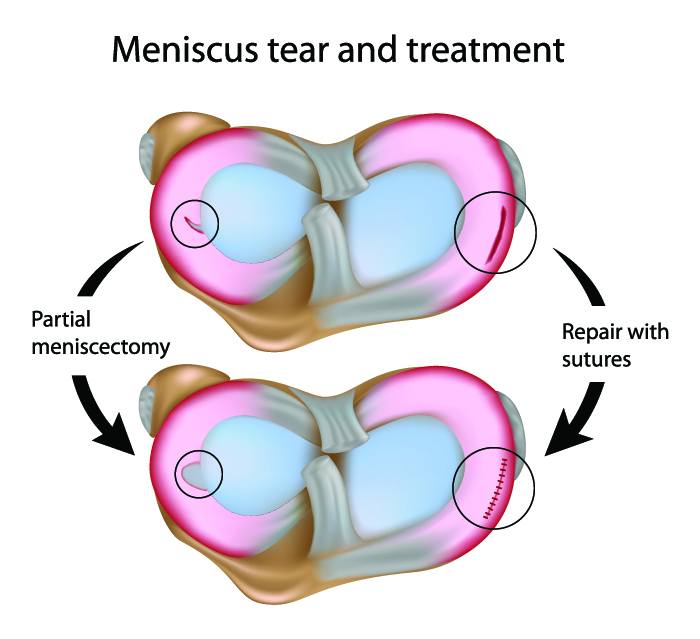Meniscus Repair Treatment & Diagnostics in Chirag Enclave, Delhi
Meniscus Repair
The meniscus is c-shaped cartilage that acts as a shock absorber between the bones of the knee. Each knee has two menisci, i.e., a medial meniscus and a lateral meniscus. Sports injuries are one of the common causes of meniscus injury. However, people may also develop meniscus injury while climbing stairs, squatting, walking on uneven surfaces, and bending the knee too far.
About Meniscus Repair Surgery
A sudden twist in the knee often causes a meniscus injury. A meniscus repair surgery is a minimally invasive surgery that is usually performed to repair the torn meniscus. If the conservative treatment of rest, ice, compression, and medication does not relieve the pain of the meniscus, then a torn meniscus injury would require meniscus repair surgery.

Who Qualifies for Meniscus Repair Surgery?
If you have pain in the knee or the knee is swollen, or the knee movement is not usual. Then in such cases, you should immediately contact your healthcare professional for further help and avoid other health hazards.
Why is Meniscus Repair Surgery Conducted?
In some cases of meniscus injury, it can be treated with NICE (Non-Steroidal Anti-Inflammatory Drugs, Ice, Compression, and Elevation) therapy or RICE (Rest, Ice, Compression, and Elevation) therapy. However, if you suspect that you are suffering from a meniscus injury, you should immediately see a doctor, as these injuries occur in the ‘white’ zone where the blood supply is not that rich. Without the support of nutrients, these injuries won’t heal. Additionally, if left untreated, then meniscus injury can lead to other knee problems. Loose meniscus cartilage moves inside the joint and may lead to knee instability, popping, and locking of the knee. Also, chronic meniscus injury may lead to arthritis. Thus, to avoid the occurrence of other knee problems, meniscus repair surgery is conducted.
What are the Different Types of Meniscus Repair Surgeries?
The different types of meniscus repair surgery are as follows:
- Arthroscopic repair - In this type of surgery, the doctor would cut the knee and insert arthroscopes for a better view of the injury. After analyzing the injury, they would place devices along with the tear and stitch it. The body would absorb these stitches with time.
- Arthroscopic partial meniscectomy - In this type of surgery, the doctor would remove a small piece of the torn meniscus so that the knee can function correctly.
- Arthroscopic total meniscectomy - In this type of surgery, the doctor would remove your complete meniscus.
What are the Benefits of Meniscus Repair Surgery?
Some of the benefits of a meniscus repair surgery are:
- It helps you to get back to your sports routine or other activities
- Improves mobility
- Increases knee stability
- Slow or prevents the development of arthritis
- Reduces pain
What are the Complications Associated with Meniscus Repair Surgery?
A meniscus repair surgery is a low-risk surgery, and the complications associated with it are infrequent. Some of the rare complications of meniscus repair surgery are:
- Infections
- Knee stiffness
- An injury to the knee nerves
- Development of arthritis in later life
- Blood clots
- Blood in the knee area
Some common symptoms of a meniscus tear are buckling, pain, popping, swelling, and inability to straighten the knee.
You are at a higher risk of developing an injury to the meniscus if you fall in any of the following criteria:
- The risk of meniscus injuries increases with the rise in age as the cartilage wears out.
- If you play sports such as basketball, tennis, golf, and others
- If you are suffering from degenerative diseases such as osteoarthritis
- If you play contact sports such as rugby, football, and hockey
The doctor would prescribe x-rays or MRI depending on the condition for detecting torn meniscus.
Care after surgery involves:
- Use knee braces to stabilize the joints as you recover
- Use crutches as it would take the load or stress of the knee as it heals
- Physical therapy
- Pain-relieving medications
- Rehabilitation exercises to restore mobility, motion, and strength of the knee
- Rest, Ice, Compression, and Elevation (RICE)
The doctor will share the schedule of follow-up check-ups. But if you develop any of the following symptoms, you should immediately consult your doctor:
- Fever
- Drainage at the incision site
- Pain even after elevation or resting of leg
- Facing trouble to breathe
Symptoms
Our Top Specialities
NOTICE BOARD
CONTACT US
CONTACT US
 Book Appointment
Book Appointment


.svg)
.svg)
.svg)
.svg)








